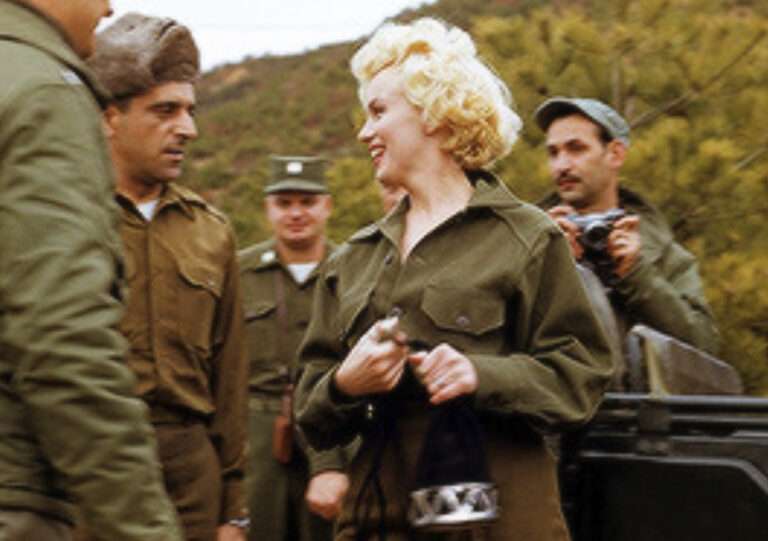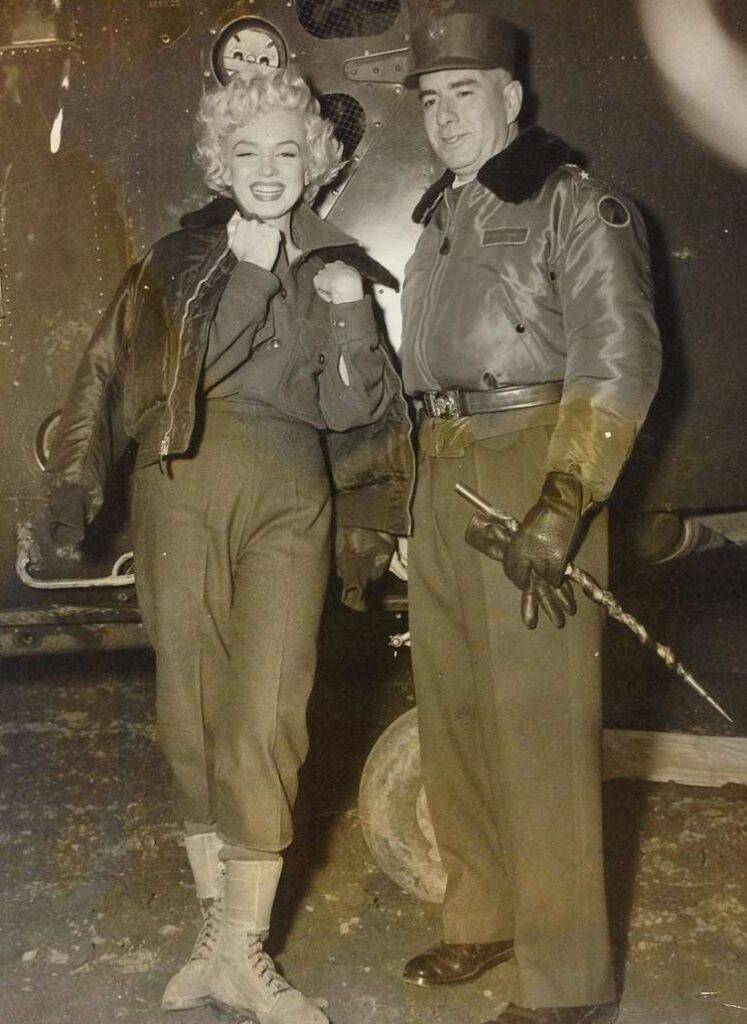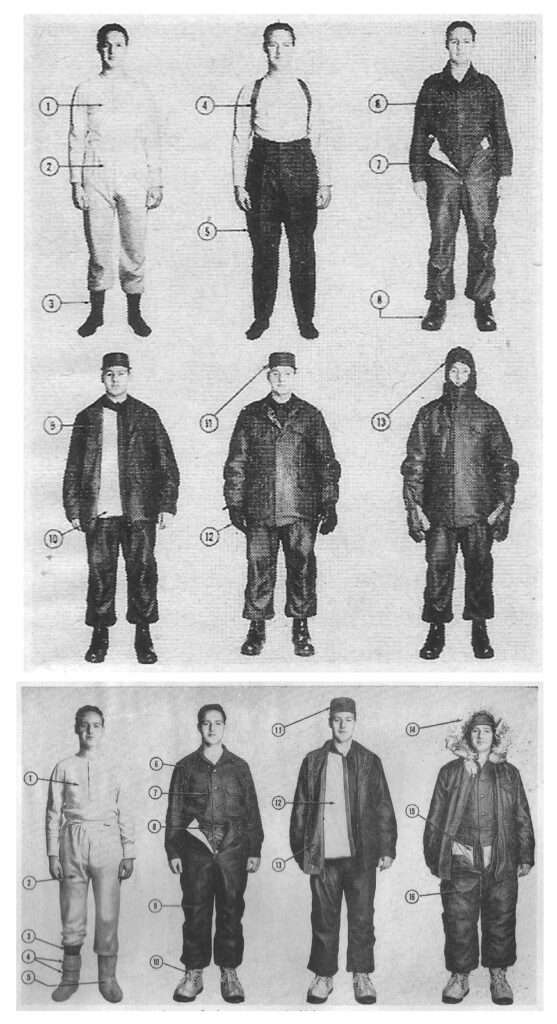
HISTORICAL
OG-108
Blanket shirt worn by Marilyn Monroe
JULY – 2023 20 MINS READ
Marilyn Monroe came to South Korea in February of 1954 while honeymooning in Tokyo with Joe DiMaggio as part of the USO entertainment during the Korean War. Her visit served as an inspiration to soldiers, and when her helicopter touched down and she stepped onto the base, the whole atmosphere changed.The shirt she was wearing was an “OG-108,” which the soldiers called a blanket shirt. (It means a shirt made of thick fabric like a blanket.)
マリリン・モンローは1954年2月、ジョー・ディマジオと東京に新婚旅行をしているときに、朝鮮戦争中のUSOの興行の一環として韓国を訪れました。彼女たちの乗ったヘリコプターが着陸後、彼女が基地に足を踏み入れた瞬間に一瞬にして雰囲気が変わったと言われています。彼女の慰問は米国軍の兵士たちに大きな癒しと勇気を与えました。そして彼女がその時に着ていたシャツは、兵隊からブランケットシャツと呼ばれているシャツ”OG-108″でした。(毛布のように厚い生地のシャツという意味)
KOREAN WAR
The Korean War was an international conflict over the sovereignty of the Korean Peninsula, which erupted between the “Republic of Korea” and the “Democratic People’s Republic of Korea” immediately after its establishment in 1948.
According to classified documents released following the collapse of the Soviet Union, on 25 June 1950, North Korea, led by Kim Il Sung with the consent and support of the Soviet Union’s Joseph Stalin, crossed the 38th parallel, which had become a de facto border line, and launched a war of aggression against South Korea. The divided Korean state, comprising North and South Korea, along with the invading South Korean side, received support from the United Nations Forces (officially the ‘UN Dispatched Force’), consisting mainly of resident US troops and other UN member states such as the United Kingdom, the Philippines, Australia, Canada, Belgium, and Thailand. Additionally, the Chinese volunteer army, known as the “Anti-mei Choso Volunteer Army,” supported by other eastern countries, joined the war as a belligerent force. The three-year war turned the entire Korean Peninsula into a battlefield and devastated the country.
On 27 July 1953, the United Nations Forces and the Sino-North Korean Allied Forces signed the Korean War Armistice Agreement, leading to an armistice, but the front line at the time of the armistice near the 38th parallel was recognized as the military demarcation line, leaving the two Koreas still divided. As of 2023, the armistice is still in effect, and no peace treaty has been signed between the two Koreas or between North and South Korea and the United Nations Forces, including the United States of America.
During the war, the US military, which dispatched the largest contingent of UN troops, received a series of consolatory visits from prominent figures such as Bob Hope, Al Jolson, and Jerry Lewis, who were at the height of their popularity at the time. They visited the front lines through bases in Japan to offer consolation and entertain the soldiers. Marilyn Monroe, who was visiting Japan on her honeymoon with Joe DiMaggio, also paid a visit to the US troops stationed in Korea after the ceasefire.
朝鮮戦争は、1948年の建国直後に「大韓民国」と「朝鮮民主主義人民共和国」の間で勃発した、朝鮮半島の主権をめぐる国際紛争です。 ソ連崩壊後に公開された機密文書によると、1950年6月25日、ソ連のヨシフ・スターリンの同意と支援を得た金日成率いる北朝鮮は事実上の国境線となっていた38度線を越え韓国に対して侵略戦争を仕掛けました。北朝鮮と韓国からなる分断された朝鮮半島は侵攻した韓国側とともに、駐留米軍を中心に、イギリス、フィリピン、オーストラリア、カナダ、ベルギー、タイなどの国連加盟国からなる国連軍(正式には「国連派遣軍」)の支援を受けます。さらに東側諸国の支援を受けた「反明朝鮮義勇軍」として知られる中国の義勇軍も参戦します。3年間の戦争は朝鮮半島全体を戦場と化し、国土を荒廃させました。
1953年7月27日、国連軍と中朝連合軍は朝鮮戦争休戦協定に調印し、休戦に至ったが、38度線付近の休戦時の前線が軍事境界線として認められ、朝鮮半島は分断されたままとなった。2023年現在、休戦協定はまだ有効であり、南北朝鮮間および南北朝鮮とアメリカ合衆国を含む国連軍との間で平和条約は締結されていない。
戦時中、国連軍最大の部隊を派遣した米軍には、ボブ・ホープ、アル・ジョルソン、ジェリー・ルイスなど、当時人気絶頂だった著名人の慰問が相次着ました。彼らは日本の基地を通じて前線を訪れ兵士たちを慰め楽しませました。特にジョー・ディマジオとの新婚旅行で日本を訪れていたマリリン・モンローは当時の西側諸国の話題を集めました。
Conflict with 20th Century Fox and marriage to Joe DiMaggio.
During the 1950s, Marilyn Monroe rose to become one of 20th Century FOX’s biggest stars. However, her contract was never reviewed after 1950, resulting in her receiving lower fees compared to other stars, and she had no say in the projects she worked on. The pressure from FOX owner Spyros Skouras to boost revenues led Zanuck to consider making her a star in a different genre of films. Unfortunately, her proposals were rejected. In January 1954, Monroe declined to appear in the musical comedy “The Girl in Pink Tights,” which led FOX to suspend her. This suspension made headlines, prompting Monroe to take immediate action to combat the negative publicity.
On January 14th, Monroe married her long-time boyfriend Joe DiMaggio at San Francisco City Hall.
On February 1, he accompanied DiMaggio, who was invited by the Yomiuri Giants to Japan for their honeymoon and received a great welcome at the Tokyo International Airport. The couple stayed in Japan for three weeks, touring Tokyo, Shizuoka, Fukuoka, Hiroshima, and Osaka. They were on good terms until Fukuoka, but when DiMaggio gave hitting lessons to Hiroshima Carp players at the Hiroshima Prefectural General Baseball Stadium, Monroe, who had been warned not to come, visited the stadium and was inundated with fans, ignoring DiMaggio. DiMaggio reprimanded Monroe, which is said to be one of the reasons for their later divorce.
During her three-day stay in Japan from February 16 1954, Monroe participated in a USO-sponsored show to comfort UN troops still stationed in Korea after the armistice of the Korean War. She sang songs from the play and other songs from her performance in front of more than 60,000 Marines.
Upon returning home, Monroe was named “Most Popular Female Star” by Photoplay magazine, and in March she settled and signed a new contract with FOX, which paid her a $100,000 bonus and promised her the lead role in a film adaptation of the successful Broadway play “Seven Year Affair.”
1950年代、マリリン・モンローは20世紀FOXの大スターにのし上がりました。しかし、1950年以降も彼女の契約が見直されることはなく、その結果彼女のギャラは他のスターに比べて低く、また彼女は出演する企画に口を出すことができませんでした。FOXのオーナーであるスピロス・スクーラスから収益を上げるよう圧力を受けたザナックは、彼女を別のジャンルの映画のスターにすることを検討しました。しかし残念ながら、彼女の提案は却下されます。1954年1月、モンローはミュージカル・コメディ『ピンクタイツの女』への出演を断り、FOXは彼女を謹慎処分にしました。この謹慎処分は大きなニュースとなり、モンローは悪評に対抗するために即座に行動を起こします。1月14日、モンローは長年のボーイフレンド、ジョー・ディマジオとサンフランシスコ市庁舎で結婚式を挙げます。そして同年の2月1日、読売ジャイアンツの招待で新婚旅行のため来日したディマジオに同行し、東京国際空港で大歓迎を受けます。夫妻は3週間日本に滞在し、東京、静岡、福岡、広島、大阪を回りました。しかし福岡までは仲睦まじかったのですが、ディマジオが広島県立総合球場で広島カープの選手に打撃指導をした際「来るな」と注意されていたモンローが球場を訪れてしまい、ディマジオを無視してファンが殺到。ディマジオはモンローを叱責しこれが後の離婚の原因のひとつになったと言われています。
1954年2月16日から3日間、日本滞在中のモンローはUSO主催で朝鮮戦争休戦後も韓国に駐留する国連軍を慰問します。6万人以上の海兵隊員の前で劇中歌などを熱唱します(動画参照)。帰国後、モンローは『フォトプレイ』誌から “最も人気のある女性スター “に選ばれ3月には和解して20世紀FOXと新たな契約を結び10万ドルのボーナスが支払われました。ブロードウェイで成功した舞台 “7年目の浮気” の映画化で主役を演じることが約束されました。










In April 1954, Otto Preminger’s western film, “The River of No Return,” which had been shot before Monroe’s suspension, was released. Although Monroe criticized the movie, describing it as a ‘Z-grade cowboy movie’ with actors’ performances overshadowed by scenery and cinemascope effects, it turned out to be a success at the box office. Following her return, Monroe starred in the musical “No Business Like Show Business,” released on December 16. However, her performance in the film was deemed vulgar by many critics, leading to its lackluster box-office performance.
In September 1954, filming commenced for “The Seven-Year Affair,” directed by Billy Wilder. Monroe portrayed a woman who becomes the object of a married man’s fantasy, played by Tom Ewell. Most of the movie was shot in a Hollywood studio, but FOX decided to film a scene in Manhattan, New York, where Monroe’s skirt, adorned in a white dress, billows up from underground vents on Lexington Avenue. This scene was intended as a publicity stunt and drew a crowd of around 2,000 spectators. It went on to become one of Monroe’s most iconic images. The film premiered in June 1955 and became one of the year’s biggest box-office hits.

1954年4月、モンローの活動休止前に撮影されていたオットー・プレミンジャー監督の西部劇映画『帰らざる河』が公開されました。モンローはこの映画を「俳優の演技が風景やシネマスコープ効果に埋もれた最低なカウボーイ映画」と批判しましたが興行的には成功しました。復帰後モンローは12月16日に公開されたミュージカル『No Business Like Show Business』にも主演します。しかし、この映画でのパフォーマンスは多くの批評家から下品とみなされ、興行成績は振るいませんでした。1954年9月、ビリー・ワイルダー監督の『7年目の浮気』の撮影が始まります。モンローはトム・イーウェル演じる既婚男性の妄想の対象となる女性を演じました。映画の大半はハリウッドのスタジオで撮影されたが、FOXはニューヨークのマンハッタンで白いドレスに身を包んだモンローのスカートがレキシントン・アヴェニューの地下通気口からせり上がるシーンを撮影することにします。このシーンは宣伝のためのもので、約2,000人の観衆を集めることになりました。その後、このシーンはマリリン・モンローの最も象徴的なイメージのひとつとなりました。この映画は1955年6月に初公開されその年最大の興行収入のひとつになりました。
OG-108 / SHIRT FIELD WOOL OLIVE GREEN-108
The Korean War commenced in 1950, and among the challenges faced by the UN forces, particularly the US forces, was the harsh cold weather on the Korean Peninsula. Having endured cold conditions during their engagements in Europe against the Germans in World War II, the US forces still found the Korean Peninsula’s cold to be quite severe. The cold protection equipment they had at the time was deemed insufficient in both quality and quantity, leading to a barrage of complaints and requests from the frontline. To address this issue, the M-1951(M-51) series was developed.
The M-51 series was designed to change between wet (14°F = minus 10°C or more) and dry (14°F = minus 10°C or less) equipment for cold weather conditions. The M-51 series includes the Field Jacket, the successor to the M-43, a famous WWII model (with a minor change, the M-50, in between), and the famous “Mod parka” The M-51 Shell Parka, the famous mod parka. And now the OG-108 shirt, where OG stands for olive green. The OG-108 was divided into early and late designs, with the divergence point around 1968. The early model is particularly distinctive in design. The shirt yoke section on the back is recognisable as that model at first glance. Thick fabric with wool 85% and nylon 15% mix. And a long collar with a tip that can be turned up to protect against the cold. The sewing from the shoulders to the sleeves in pursuit of ease of movement is used continuously until the late models. (The crossed yoke, which was characteristic, maybe discontinued, perhaps due to manufacturing problems)
1950年に始まった朝鮮戦争。参戦したアメリカ軍(国連軍)が直面した最も困難の問題の中に朝鮮半島の厳しい寒さがありました。第二次世界大戦のヨーロッパでのドイツ軍との交戦で寒さに耐えた米軍にとっても朝鮮半島の寒さはやはり相当厳しいものでした。当時の防寒装備では質・量ともに不十分で前線から苦情や要望が相次い求ことになります。そこで開発されたのがM1951=M51シリーズです。
M-51シリーズは、ウェット(14°F=マイナス10℃以上)とドライ(14°F=マイナス10℃以下)の寒冷地の状態によって装備を切り替えられるように設計されいました。このM-51シリーズには、第二次大戦モデルとして有名なM-43の後継モデルであるフィールドジャケット(間にマイナーチェンジしたM-50があります) そして有名な “モッズパーカ “M-51 Shell Parkaなどがあります。そして今回のOG-108シャツですが、この品番のOGはオリーブグリーンの略です。OG-108は前期型と後期型に分かれ、その分岐点は1968年頃だと思われます。特に前期型はデザインに特徴があります。背中のシャツヨーク部分は一目でそのモデルとわかるクロスヨーク。ウール85%、ナイロン15%の混紡の寒さに対応した厚手の生地。そして、寒風を防ぐために先端を立ち上げることができる長めの襟。動きやすさを追求した肩から袖にかけての縫製は後期モデルまで継続して採用されました。(特徴的だった交差ヨークは、製造上の問題からか、廃止されたのだろう)

MILITARY SPECIFICATIONS / 1 AUG 1949
OG-108 EARLY MODEL (1951 – 1968)

Cold-Wet/Cold-Dry Clothing System (M-1951)
The combination Cold-Wet/Cold-Dry Clothing System (M-1951) can be configured into two ensembles. The cold-wet ensemble is worn above 14°F, and the cold-dry ensemble is worn below 14°F. The cold-dry ensemble protects down to -60°F. The cold-wet configuration differs from the cold-dry in the number of layers and the choice of boots. The system uses layers of wool/cotton fabrics to trap air for insulation, and a water-repellent outer garment to maintain dryness
Cold Weather Conditions
The use of cold weather clothing is affected by two types of weather conditions: wet and dry. These conditions are amplified by humidity coupled with temperature and wind velocity; high humidity (wet conditions), low humidity (dry conditions).
Cold-wet conditions occur when temperatures are near freezing and variations in day and night temperatures cause alternate freezing and thawing. This freezing and thawing is often accompanied by rain and wet snow, causing the ground to become muddy and slushy. During these periods troops should wear clothing which consists of a water-repellent, wind-resistant outer layer and inner layers with sufficient insulation to provide ample protection in moderately cold weather (above 14°F).
Cold-dry conditions occur when average temperatures are lower than 14°F. The ground is usually frozen and snow is usually dry, in the form of fine crystals. Strong winds cause low temperatures to seem colder and increase the need for protection of the entire body (windchill). During these periods, troops should have available additional insulating layers of clothing. This is particularly true when entering static situations form a period of strenuous exercise.








OG-108/Early model Printed tag White type, Red type (Text already transcribed from photo)
1951-01-22: MIL-S-10858(QMC); SHIRT, FIELD, WOOL, OLIVE GREEN 108
1951-04-04: MIL-C-11065(QMC); CLOTH, WOOL/NYLON, SHIRTING, 16 OUNCE SHRINK RESISTANT
1951-11-03: Revision A
1952-11-04: Amdt

1954-01-05: Revision A Amdt .2
1954-01-05: Revision A Amdt .2
1956-07-10: Revision B Amdt. 1; SHIRT, MAN’S FIELD, WOOL/NYLON, OLIVE GREEN SHADE NO. 108
1958-06-27: Revision A; CLOTH, WOOL/NYLON, SHIRTING, 16 OUNCE, SHRINK RESISTANT
1959-03-20: Revision C


1960 April / Index of specifications and standards / MIL-C-11065
OG-108 LATE MODEL (1968 – 1995)
Wool Field Shirt
The wool field shirt is intended for wear as a component of the cold-wet and cold-dry uniforms for temperate and cold areas.
Material
The shirt is made of shrink resistant 16 ounce olive green 108 wool and nylon cloth, conforming to MIL-C-11065.
Description
The shirt has grown-on facings, two chest patch pockets with buttoned flapsand a pencil pocket in left breast pocket, a double-ply collar, and one button and buttonhole on each sleeve cuff. The shirt tail has a square design to permit wearing either outside or inside the trousers.
Nomenclature
▪︎ SHIRT, FIELD, WOOL, OLIVE GREEN 108
▪︎SHIRT, COLD WEATHER, FIELD, WOOL/NYLON, OLIVE GREEN 108
▪︎SHIRT, COLD WEATHER, FIELD, WOOL/NYLON, OLIVE GREEN 108


1968 April / Basic cold weather manual
1968-02-29: Revision F
1970-09-18: Revision F Amdt. 1
1970-12-23: Revision F Amdt. 2
1971-09-01: Revision F Amdt. 3
1972-06-05: Revision F Amdt. 4
1972-07-13: Revision F Amdt. 5
1974-05-24: Refision F
1976-12-09: Revision G
1980-06-09: Revision G Amdt. 1
1983-01-07: Revision H, SHIRT, COLD WEATHER, FIELD, WOOL/NYLON, OLIVE GREEN 108
1983-10-11: Revision G; CLOTH, FLANNEL, WOOL AND NYLON, 16-OUNCE, SHRINK RESISTANT
1983-10-11: Revision G; CLOTH, FLANNEL, WOOL AND NYLON, 16-OUNCE, SHRINK RESISTANT
1989-04-22: Revision G Notice 1 – validation
1995-04-24: Revision G Notice 2 – cancellation
Is the model she wore an early or late model “OG-108”?
It is generally accepted that Marilyn Monroe wore the OG-108 early model when she visited Korea for comfort in 1954. This is not surprising, considering it was well before 1968 when the early model was replaced by the late model. However, upon examining the video and existing photos, uncertainty arises, as none of them clearly show the characteristic cross yoke or the pen stick in the left breast pocket of the early type. Nevertheless, our research confirmed those features, allowing us to state with certainty that she was indeed wearing the OG-108 early model.
一般的にはマリリンモンローは韓国へ行った時にはOG-108 前期型を着ていたと言われています。彼女が慰問に訪れたのは1954年です。それは後期型に変わる1968年より随分と前であるので当然です。しかし映像や現存する写真を見ていると前期型に特徴的なクロスヨークもしくは左胸のポケットのペン刺しがはっきり写っているものがないため確実性に欠けていました。しかし今回調査した結果、それらの特徴を確認することができました。彼女は間違いなくOG-108前期型を着用していると断定できます。







The presence of the cross yoke on the back in the video cannot be confirmed, but the last photo provides particularly conclusive evidence. The yoke on the back of the shirt is clearly visible. The distinctive sleeve attachment is another characteristic feature of the early OG-108 models. The pen pocket on the left chest is also clearly visible. The curved collar is another prominent feature of the early OG-108 model.
映像では背中のクロスヨークの存在ははっきりとは確認できませんが、最後の写真が決定的な証拠となります。背中のヨークがはっきりと確認できます。また特徴的な袖付けもOG-108の特徴です。左胸のペンポケットもはっきり確認できます。襟先に向かってカーブした襟もOG-108初期モデルの顕著な特徴です。
Marilyn Monroe KILLS SELF
In the spring of 1962, Monroe was again in the public eye when she won the Golden Globe ‘Henrietta Award’ and it was announced that a new film, The Wife Was Alive, was in production. A few days before filming began, Monroe contracted a sinus infection. Ignoring doctors’ advice that filming should be postponed, FOX began filming in late April as planned. Monroe missed most of the first six weeks of filming due to illness. Despite multiple doctor’s diagnoses, FOX pressured her to appear for filming, claiming she was using a temporary illness; on 19 May, she took time off from filming to perform on stage at Madison Square Garden in New York City to celebrate then-President John F. Kennedy’s birthday with ” She sang ‘Happy Birthday to You’. Monroe appeared on stage wearing a beige dress with rhinestones that emphasised her curves, leading many onlookers to mistake her for appearing naked. At this time, the President’s wife, Jacqueline Kennedy, was not present when she found out that Monroe was coming to the ceremony. Afterwards, she was fired from FOX due to the film’s cancellation, failure and other problems, including being sued for damages (she settled with FOX), and it is said that she chose to commit suicide on 5 August 1962.
1962年春に彼女はゴールデングローブ「ヘンリエッタ賞」を受賞し、新作映画『女房は生きていた』の制作が発表されたことで再び注目を集めます。撮影開始の数日前モンローは副鼻腔炎に罹った。映画の撮影は延期すべきという医師の助言を無視しFOXは予定どおり4月下旬から撮影を開始します。モンローは病気で撮影入り後6週間の大半を欠席します。複数の医師による診断があったにも拘らずFOXは彼女が仮病を使っていると主張して撮影に出てくるよう圧力をかけました。5月19日、彼女は撮影を休んで、ニューヨークのマディソン・スクエア・ガーデンで行われた当時の大統領ジョン・F・ケネディの誕生日を祝うステージで「ハッピーバースデー・トゥー・ユー」を歌いました。このときモンローはラインストーンで身体のラインが強調されたベージュ色のドレスを身に着けてステージに登場したので、見た人々の多くが裸で登場したのかと見間違えました。このとき大統領夫人ジャクリーン・ケネディは式典にモンローが来ると知り欠席しました。その後映画の撮影中止、失敗などでFOXを解雇され損害賠償の裁判を起こされるなど度重なる問題が発生したこともあり(FOXとは和解)1962年8月5日に自殺を選択したと言われています。

The front page of the New York Daily Mirror published on August 6, 1962 ©wilipediacomon
